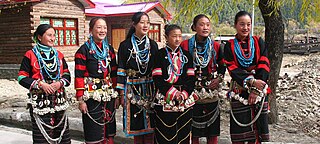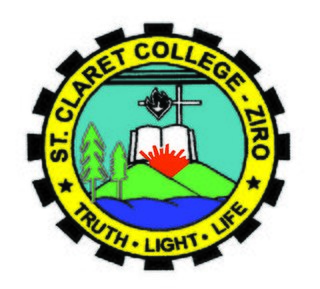
Arunachal Pradesh is a state in northeast India. It was formed from the North-East Frontier Agency (NEFA) region, and India declared it as a state on 20 February 1987. Itanagar is its capital and largest town. It borders the Indian states of Assam and Nagaland to the south. It shares international borders with Bhutan in the west, Myanmar in the east, and a disputed 1,129 km border with China's Tibet Autonomous Region in the north at the McMahon Line. Arunachal Pradesh is claimed by China as part of the Tibet Autonomous Region; China occupied some regions of Arunachal Pradesh in 1962 but later withdrew its forces.

The Ahom script or Tai Ahom Script is an abugida that is used to write the Ahom language, a dormant Tai language undergoing revival spoken by the Ahom people till the late 18th-century, who established the Ahom kingdom and ruled the eastern part of the Brahmaputra valley between the 13th and the 18th centuries. The old Ahom language today survives in the numerous manuscripts written in this script currently in institutional and private possession.

Sinhala, sometimes called Sinhalese, is an Indo-Aryan language primarily spoken by the Sinhalese people of Sri Lanka, who make up the largest ethnic group on the island, numbering about 16 million. Sinhala is also spoken as the first language by other ethnic groups in Sri Lanka, totalling about 2 million speakers as of 2001. It is written using the Sinhala script, which is a Brahmic script closely related to the Grantha script of South India.
Lao script or Akson Lao is the primary script used to write the Lao language and other minority languages in Laos. Its earlier form, the Tai Noi script, was also used to write the Isan language, but was replaced by the Thai script. It has 27 consonants, 7 consonantal ligatures, 33 vowels, and 4 tone marks.
The Odia script is a Brahmic script used to write primarily Odia language and others including Sanskrit and other regional languages. It is one of the official scripts of the Indian Republic. The script has developed over more than 1000 years from a variant of Siddhaṃ script which was used in Eastern India, where the characteristic top line transformed into a distinct round umbrella shape due to the influence of palm leaf manuscripts and also being influenced by the neighbouring scripts from the Western and Southern regions.

The Apatani people are an ethnic group who live in the Ziro valley of Arunachal Pradesh's Lower Subansiri region.
The Tani language, often referred to as Tani languages, encompasses a group of closely related languages spoken by the Tani people in the northeastern region of India, primarily in the state of Arunachal Pradesh and Assam. These languages belong to the Sino-Tibetan family and include several major dialects such as Nyishi, Galo, Apatani, Adi, Tagin, and Mising.
Tshangla is a Sino-Tibetan language of the Bodish branch closely related to the Tibetic languages. Tshangla is primarily spoken in Eastern Bhutan and acts as a lingua franca in the region; it is also spoken in the adjoining Tawang tract in the Indian state of Arunachal Pradesh and the Pemako region of Tibet. Tshangla is the principal pre-Tibetan language of Bhutan.

The Khamti language is a Southwestern Tai language spoken in Myanmar and India by the Khamti people. It is closely related to, and sometimes considered a dialect of, Shan.

Sora is a south Munda language of the Austroasiatic language of the Sora people, an ethnic group of eastern India, mainly in the states of Odisha and Andhra Pradesh. Sora contains very little formal literature but has an abundance of folk tales and traditions. Most of the knowledge passed down from generation to generation is transmitted orally. Like many languages in eastern India, Sora is listed as 'vulnerable to extinction' by UNESCO. Sora speakers are concentrated in Odisha and Andhra Pradesh. The language is endangered as per as International Mother Language Institute (IMLI).

The Tani people are a Sino-Tibetan ethnic group of peoples, which includes the Adi, Apatani, Galo, Mising, Nyishi and Tagin, who share common beliefs, ancestry, and Tani languages and live in the Indian states of Arunachal Pradesh and Assam, as well as the Tibet Autonomous Region in China.
Mising is a Tani language spoken by the Mising people. There are 629,954 speakers, who inhabit mostly in the Dhemaji district, Lakhimpur, Sonitpur, Dibrugarh, Sibsagar, Jorhat, Majuli, Golaghat, Tinsukia districts of Assam and also some parts of Arunachal Pradesh. The primary literary body of Mising is known as 'Mising Agom Kébang '.

Tai Tham script is an abugida writing system used mainly for a group of Southwestern Tai languages i.e., Northern Thai, Tai Lü, Khün and Lao; as well as the liturgical languages of Buddhism i.e., Pali and Sanskrit. It is historically known as Tua Tham. In Thailand and Myanmar, the script is often referred to as Lanna script in relation to the historical kingdom of Lan Na situating in the Northern region of modern day Thailand and a part of Shan state in Myanmar. Local people in Northern Thailand also call the script as Tua Mueang in parallel to Kam Mueang, a local name for Northern Thai language. In Laos and Isan region of Thailand, a variation of Tai Tham script, often dubbed Lao Tham, is also known by the locals as To Tham Lao or Yuan script. Tai Tham script is traditionally written on a dried palm leaf as a palm-leaf manuscript.

The Idu Mishmi language is a small language spoken by the Mishmi people in Dibang Valley district, Lower Dibang Valley district, Lohit district, East Siang district, Upper Siang district of the Indian state of Arunachal Pradesh and in Zayü County of the Tibet Autonomous Region, China. There were 8569 speakers in India in 1981 and 7000 speakers in China in 1994. It is considered an endangered language.
Koro is a language spoken in Arunachal Pradesh, India.

Saint Claret College, Ziro (SCCZ) is a Catholic undergraduate college established in the Himalayan foothills at Ziro, Arunachal Pradesh, India. Founded in 2003, SCCZ is served by Claretian Missionaries, a Roman Catholic Order founded by St. Anthony Mary Claret and that serves in 64 countries. Saint Claret College at Ziro is permanently affiliated to Rajiv Gandhi Central University, Itanagar. SCC is recognized by the University Grants Commission (UGC) and is accredited with "A" Grade by the National Assessment and Accreditation Council (NAAC), Bangalore. SCCZ offers Bachelor of Arts, B. A., and B. Com, besides several certificate courses.
Bori is a Tani language of India. Bori is spoken in Payum Circle, West Siang District, Arunachal Pradesh.

Tangsa, also known as Tase and Tase Naga, is a Sino-Tibetan language or language cluster spoken by the Tangsa people of Burma and north-eastern India. Some varieties, such as Shangge (Shanke), are likely distinct languages. There are about 60,000 speakers in Burma and 40,000 speakers in India. The dialects of Tangsa have disparate levels of lexical similarity, ranging from 35%–97%.
Wancho script is an alphabet created between 2001 and 2012 by middle school teacher Banwang Losu in Longding district, Arunachal Pradesh for writing the Wancho language. Letters represent consonants and vowels. Conjunct consonants are not used. Tone is indicated with diacritical marks on vowel letters.











